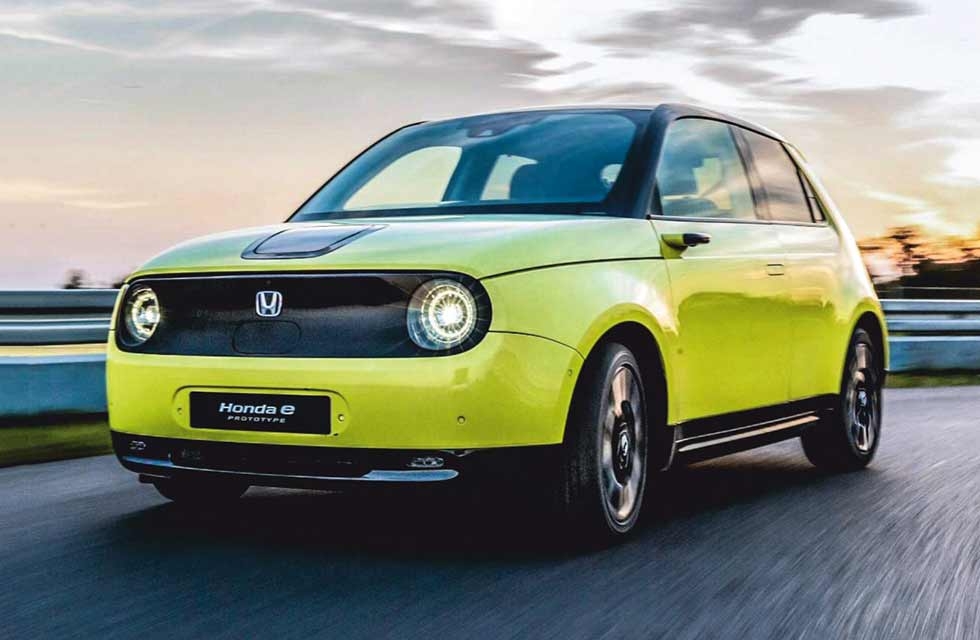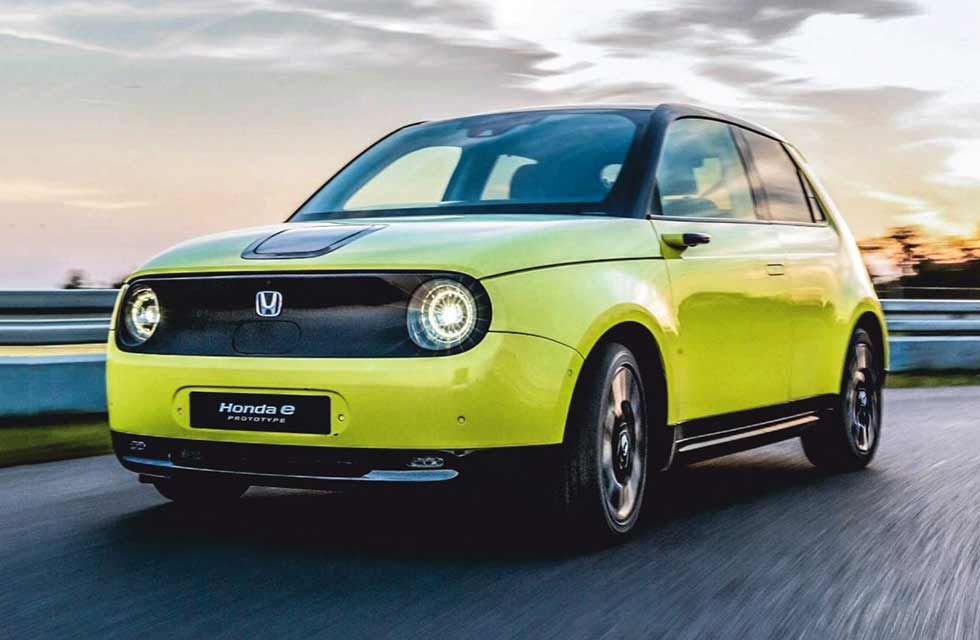
Honda’s Apple Gamble. Larger but similarly priced EVs are capable of doubling or tripling the Honda’s range Retro-futurist cabin: mirrors from the future, faux wood veneer from 1972.
2020 Honda E
The range is terrible and the price is high. Ah, but those looks…
While the exterior may have been toned down compared with its fantastic concept car preview, the Honda E’s interior is still a dramatic departure from everything else the brand makes today. In this not-quite-finished prototype there isn’t a single rough edge, frayed corner or malfunctioning component.

It’s a blend of familiar and futuristic in here; the thin-rimmed, twospoke steering wheel and grained wood dashtop contrast with the gigantic glossy infotainment displays. It’s also deceptively roomy. The styling may be inspired by the tiny original Honda Civic, but the dimensions are closer to the current Jazz, and it’s easily accessible for adults who aren’t gymnasts. The cameras that replace conventional door mirrors are fitted as standard on the E, unlike the Audi e-Tron’s optional equivalents. They work well; the display’s high frame rate means no re-focusing of your vision when glancing at the well-placed screens. The central rear-view camera less so; like JLR’s ClearView mirror, it requires far more concentration to adjust your eyes than is comfortable.
Still, placing the E on the road and in a parking space is a breeze. Visibility is impressive, even without the use of the cameras, and the supremely tight turning circle of 4.3 metres (the front wheels can turn by up to 45º) gives the Honda E a zippiness few cars can match.
Under your feet is a 35.5kWh battery pack feeding an electric motor in the back, making 148bhp and ‘more than’ 221lb ft, driving the rear wheels. The battery pack’s location contributes to 50:50 weight distribution as well as a low centre of gravity. MacPherson strut suspension all-round suggests packaging efficiency was a priority over ride or handling, but Honda has benchmarked bigger cars on those fronts. Our drive around a completely flat, smooth test facility particularly challenged the suspension.
From behind the wheel, there’s plenty the E gets right. The controls are well weighted, with a progressive brake pedal movement and some resistance in the throttle action – something few EVs really nail. It’s the same story with the steering, which brings a touch of heft to your inputs. It’s not sporty, but you can engage with the E; it feels like it enjoys being thrown around sharp corners. Body roll isn’t excessive, though we’d like some thicker side bolstering on those seats.
This is a decent performer. It punches harder than a Renault Zoe, with real get-up-and-go to 50mph, accompanied by a proper Starship Enterprise whooshing noise. Sport mode changes the torque curve to hit max boost earlier, and a useful Single Pedal Control system similar to the Nissan Leaf’s e-Pedal switch for urban driving. But there are two big obstacles: range and price, which tend to get linked in potential buyers’ calculations. A 124-mile range is not great, especially when you consider larger but similarly-priced EVs like the Hyundai Kona Electric, Kia e-Niro and Tesla Model 3 are capable of doubling or tripling that figure for the Honda’s estimated £35k price tag.
Honda’s project leader, Kohei Hitomi, is confident that this won’t be a problem. ‘Like smartphones, if you’re budget conscious, you’re not going to go for an iPhone X. But if you’re really keen on the tech and features, the price becomes a secondary priority. That’s what we believe, and hope that people opt for the car because of the design or the features.
‘Also, like smartphones, it’s better to have a simple design for a complicated device – if the design is already complicated, it’s very difficult to accept new technology. We tend not to use the word “retro” as that sounds old – it’s more a nostalgic and familiar design language.’
The E is trying to do a lot all at once: take Honda into the EV market in direct competition with the new electric Mini, Peugeot 208 and many other entrants to a suddenly teeming market; take Honda further into premium territory than it’s ever previously managed; and transform perceptions about Honda interiors. A low range and a high price stacks the odds a little higher than is ideal – but on the way it looks and drives Honda’s E has a fighting chance.
PRICE From £35,000 (est)
POWERTRAIN Single e-motor, rear-wheel drive
PERFORMANCE 148bhp, 8sec
0-62mph 8.0sec
MAX SPEED 100mph (limited)
WEIGHT 1500kg (est)
ON SALE 2020
EFFICIENCY 124-mile range






